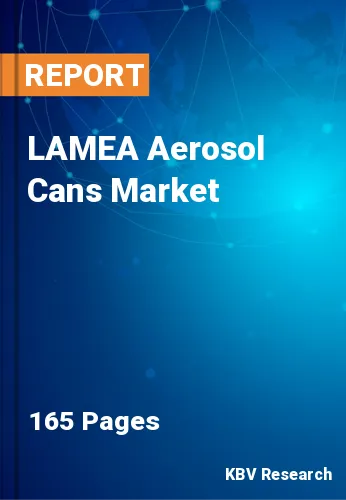The Latin America, Middle East and Africa Aerosol Cans Market would witness market growth of 5.0% CAGR during the forecast period (2023-2030). In the year 2026, the LAMEA market's volume is expected to surge to 2,146.7 million units, showcasing a growth of 6.8% (2023-2030).
The ease of use and precision dispensing provided by aerosols align with modern lifestyles. Evolving environmental regulations and the growing emphasis on sustainable practices are compelling manufacturers to adopt eco-friendly materials and reduce their carbon footprint. Regulatory compliance is a significant factor influencing product development and market strategies. Continuous advancements in valve technology, propellant formulations, and materials science are enhancing the performance and sustainability of aerosol cans. These innovations contribute to the market's growth and competitiveness. Economic stability, disposable income, and consumer spending power directly impact the demand for aerosol products. Economic fluctuations can affect the affordability and purchasing patterns of consumers.
The market is characterized by intense competition among manufacturers and suppliers. Companies that can differentiate their products through innovation, quality, and sustainability gain a competitive edge. Safety is paramount in the aerosol cans market. Any incidents or health concerns related to aerosol products can impact consumer trust and regulations. Manufacturers must maintain high safety standards. The efficiency of distribution channels and partnerships with retailers can significantly affect the accessibility and visibility of aerosol products. Effective distribution strategies are vital for market penetration. Changing demographics, like an aging population or a younger generation with unique preferences, can influence the types of products and packaging demanded in the market.
The market in LAMEA is smaller in comparison to more developed regions, but it is gradually growing. Economic factors, industrial development, and consumer preferences in different countries within the region influence the market’s growth. Economic conditions in the LAMEA region can be diverse, ranging from highly developed economies to emerging markets. Financial stability, disposable income levels, and industrialization have a significant impact on the demand for aerosol can-packaged products. In some countries within the LAMEA region, there is a growing focus on sustainability and ecological responsibility. Manufacturers are responding by using eco-friendly materials and propellants in aerosol cans to meet these demands. The elements mentioned above will boost the market growth in this region.
The Brazil market dominated the LAMEA Aerosol Cans Market by Country in 2022 and would continue to be a dominant market till 2030; thereby, achieving a market value of $381.2 million by 2030. The Argentina market is showcasing a CAGR of 5.6% during (2023 - 2030). Additionally, The UAE market would register a CAGR of 4.7% during (2023 - 2030).
Based on Type, the market is segmented into Liquefied Gas, and Compressed Gas. Based on Product Type, the market is segmented into 1-piece cans, and 3-piece cans. Based on Material, the market is segmented into Aluminium, Steel, Plastic, and Others. Based on End-use, the market is segmented into Personal Care, Household Care, Automotive, Healthcare, and Others. Based on countries, the market is segmented into Brazil, Argentina, UAE, Saudi Arabia, South Africa, Nigeria, and Rest of LAMEA.
Free Valuable Insights: The Worldwide Aerosol Cans Market is Projected to reach USD 14.5 Billion by 2030, at a CAGR of 3.7%
The market research report covers the analysis of key stakeholders of the market. Key companies profiled in the report include Amcor Plc, Mondi Plc, The International Paper Company, DS Smith Plc., Rengo Co., Ltd., Sealed Air Corporation, Berry Global Group, Inc., CCL Industries Ltd., Sonoco Products Company, and Smurfit Kappa Group plc.
By Type (Volume, Million Units, USD Million, 2019-2030)
By Product Type (Volume, Million Units, USD Million, 2019-2030)
By Material (Volume, Million Units, USD Million, 2019-2030)
By End-use (Volume, Million Units, USD Million, 2019-2030)
By Country (Volume, Million Units, USD Million, 2019-2030)
Our team of dedicated experts can provide you with attractive expansion opportunities for your business.

